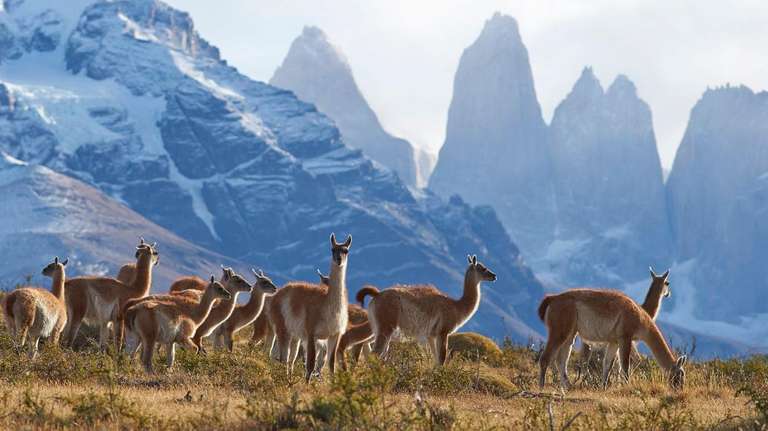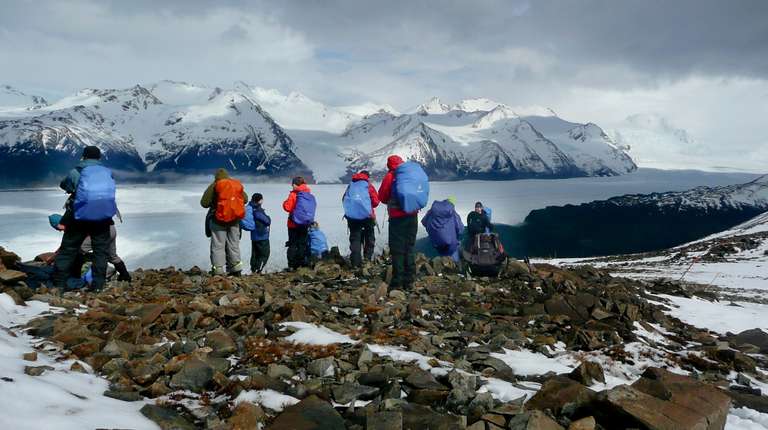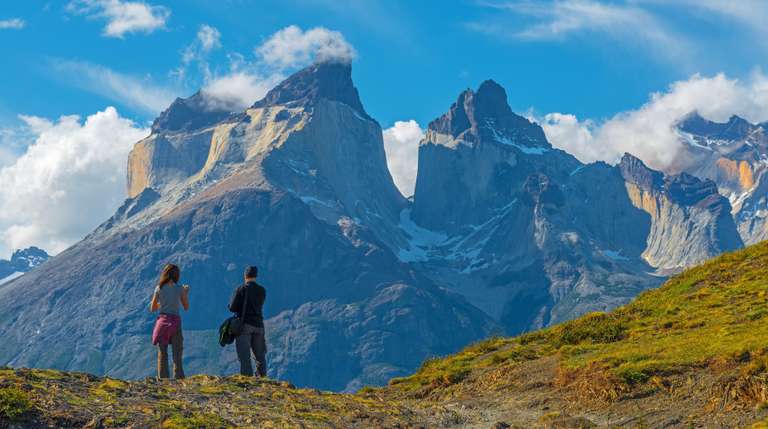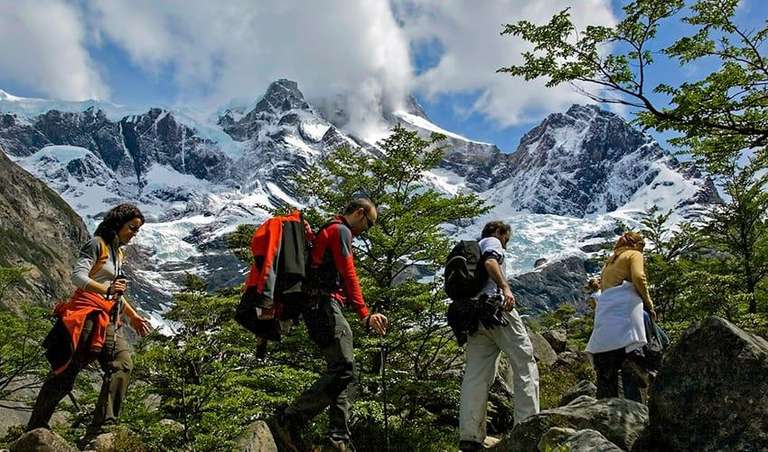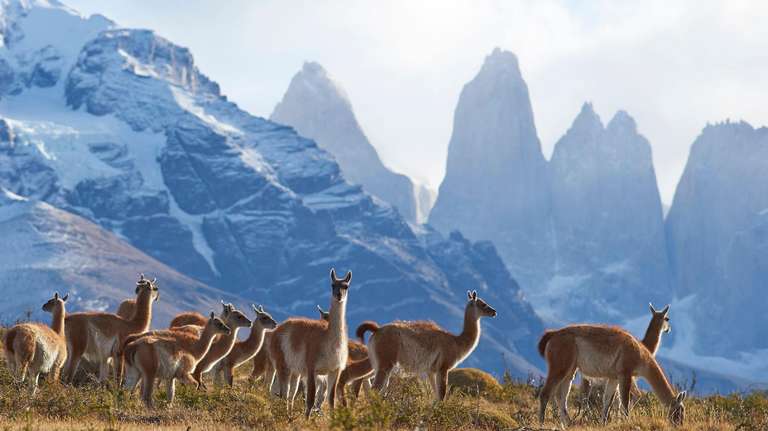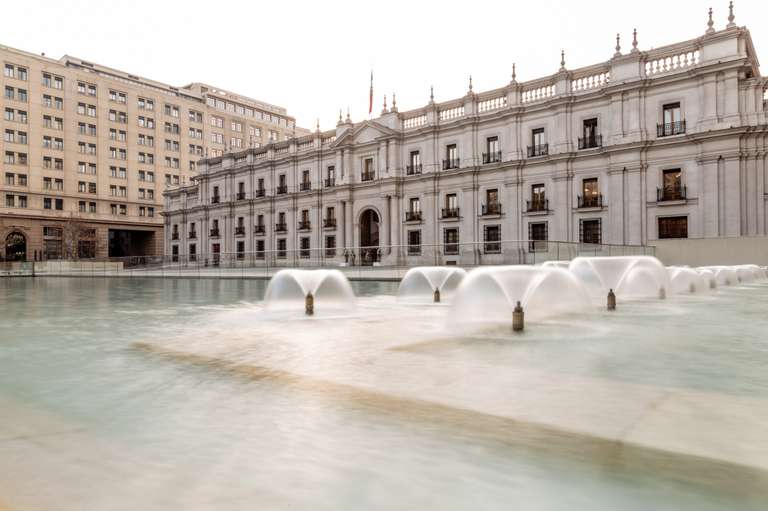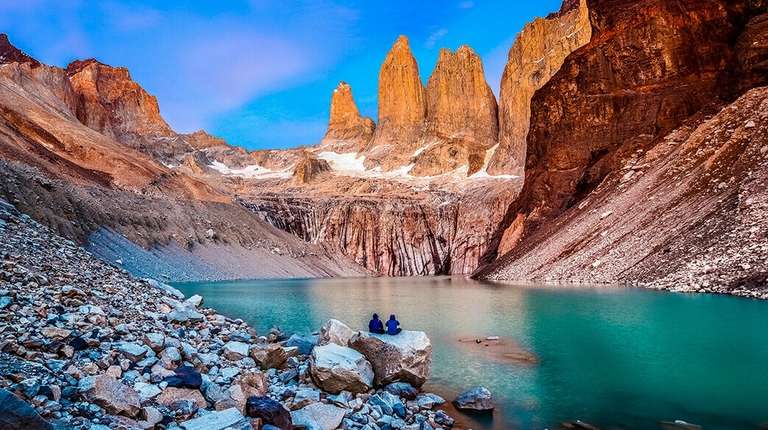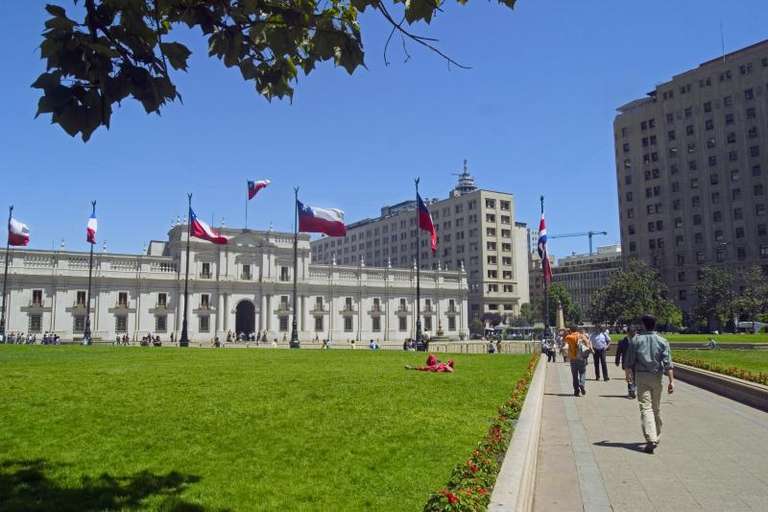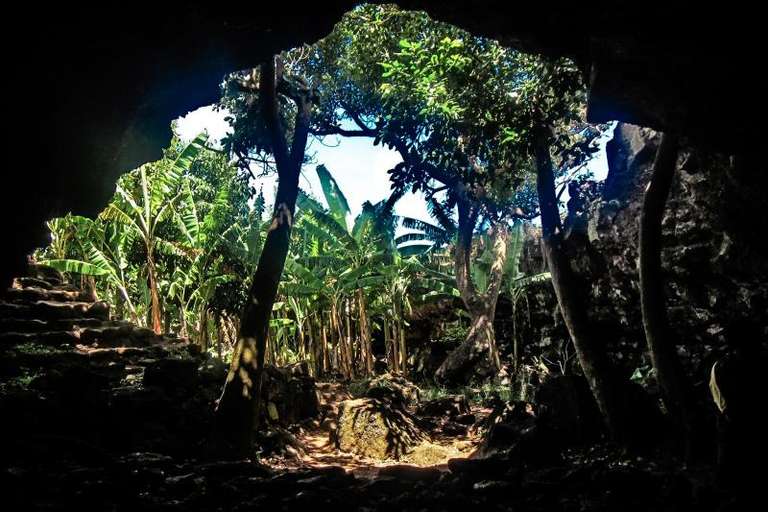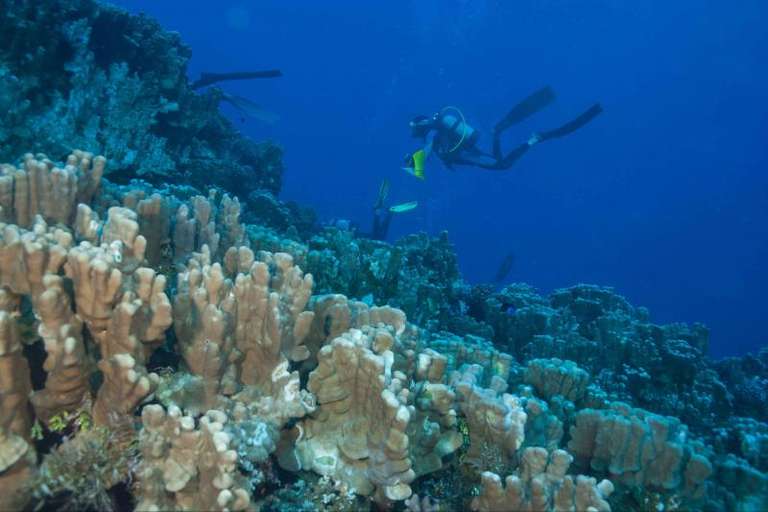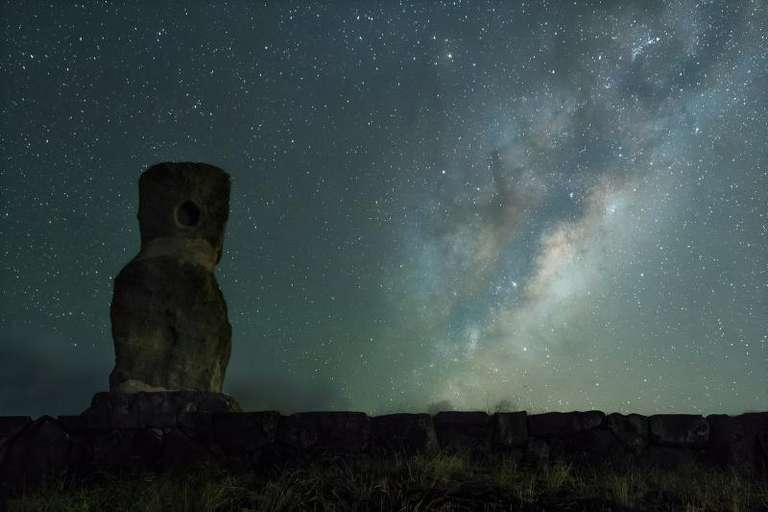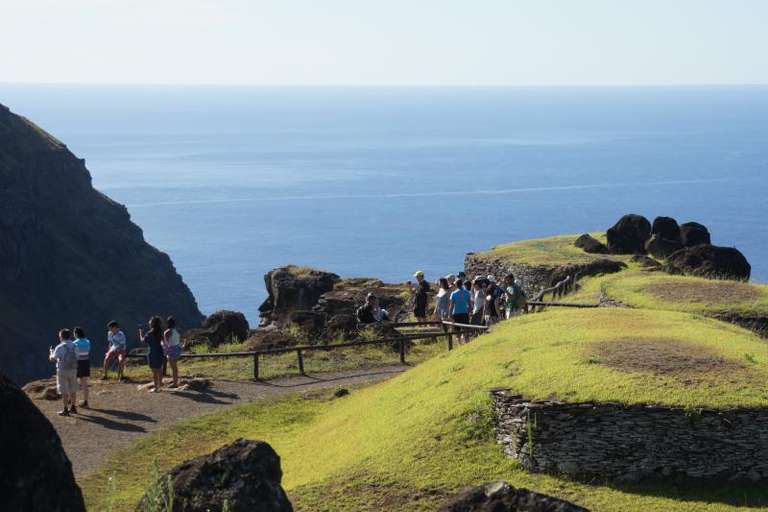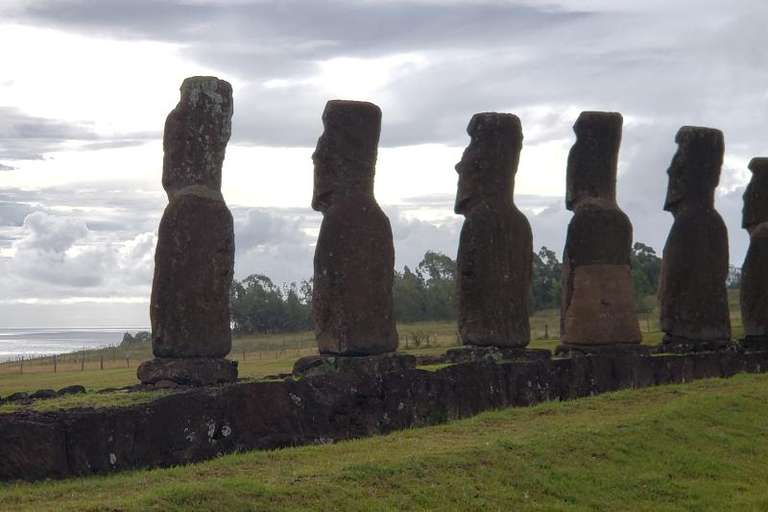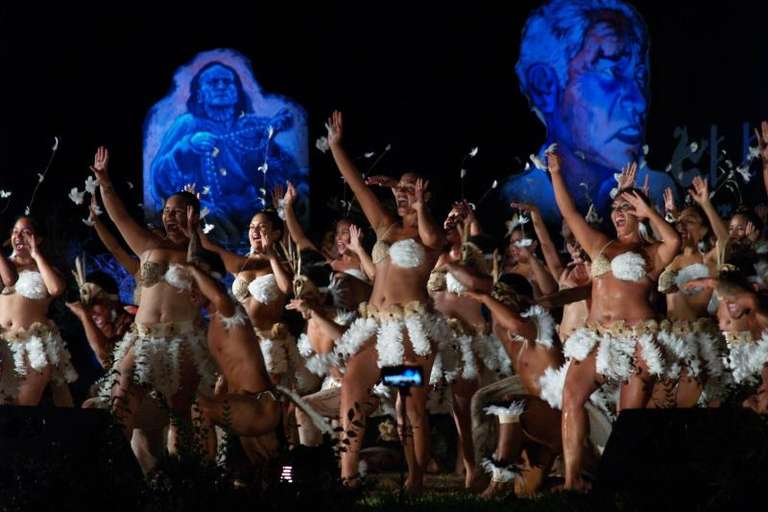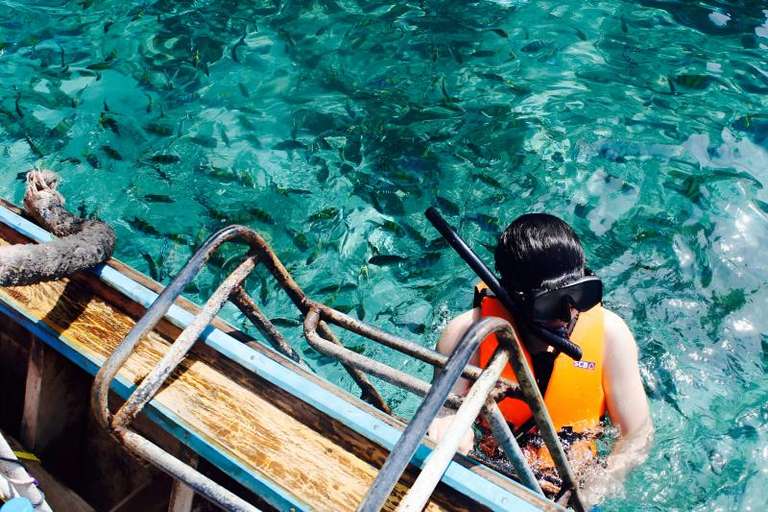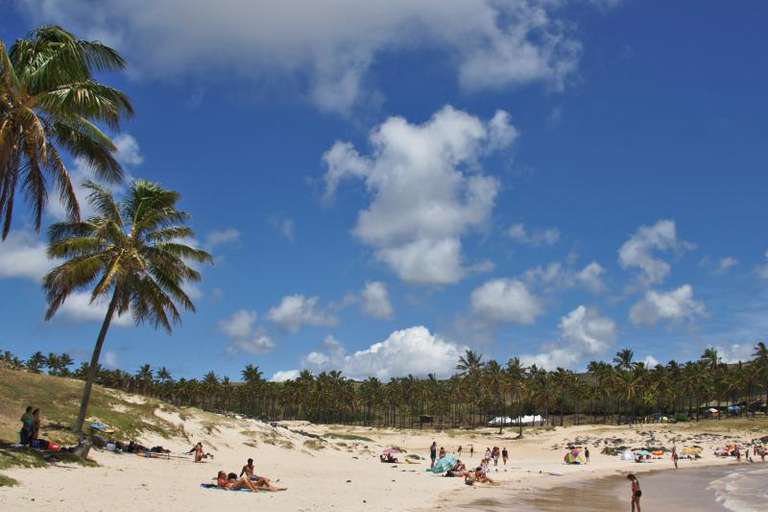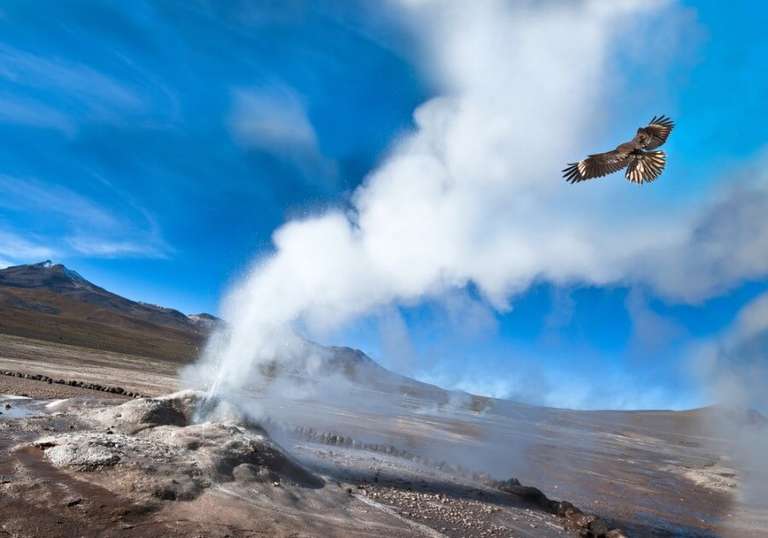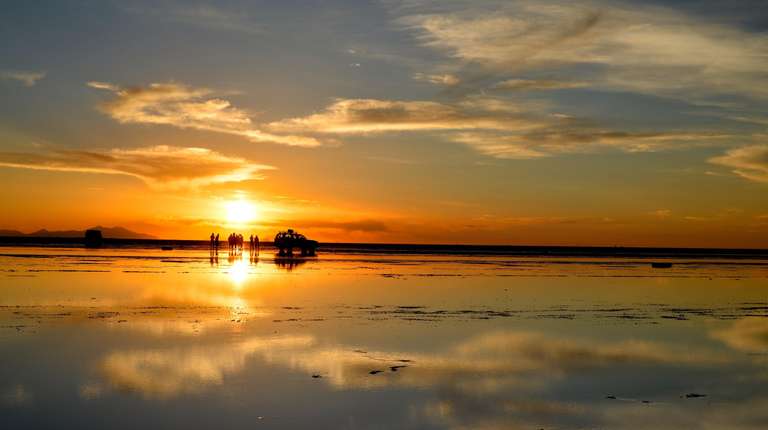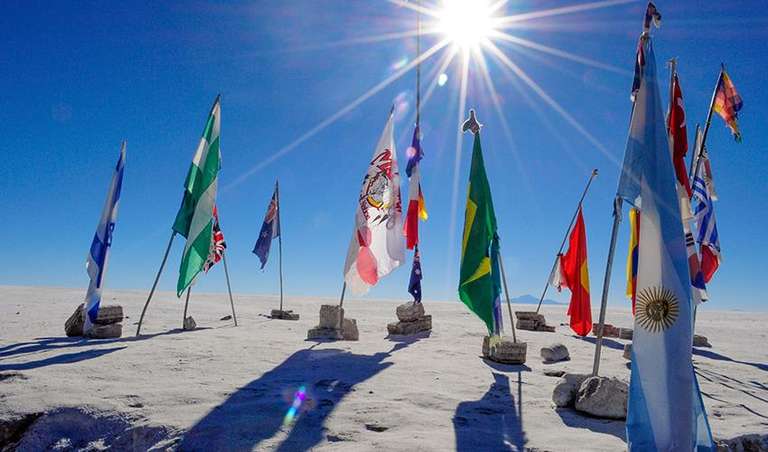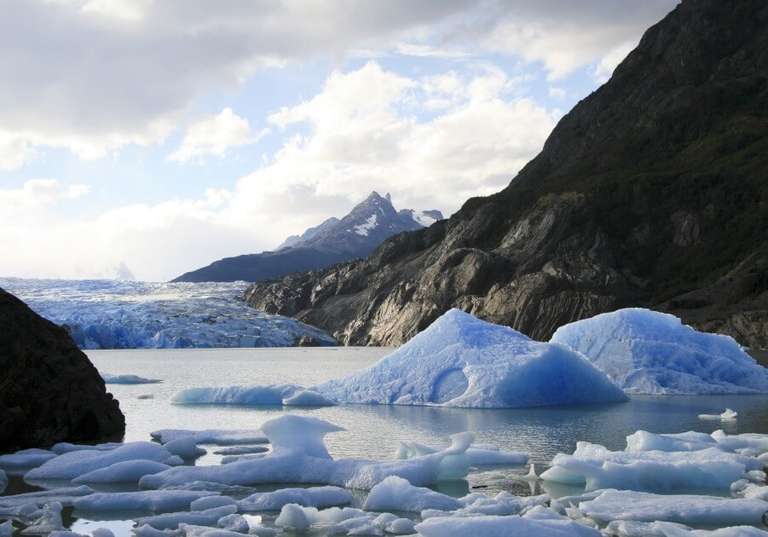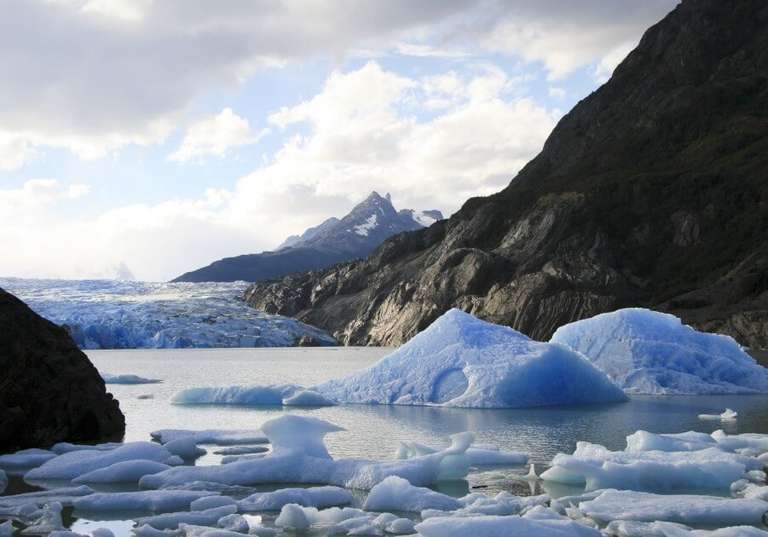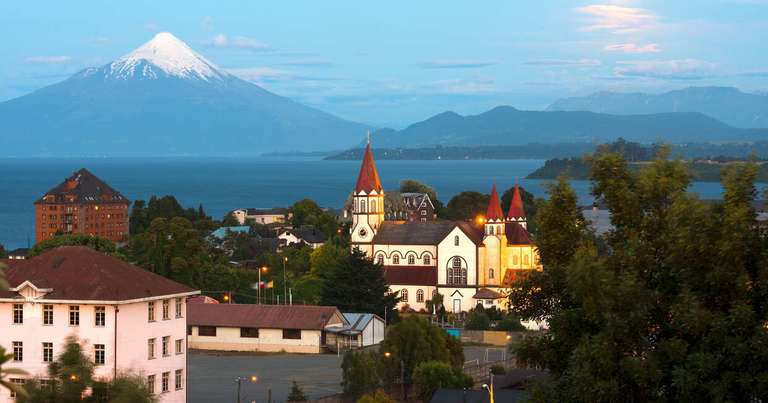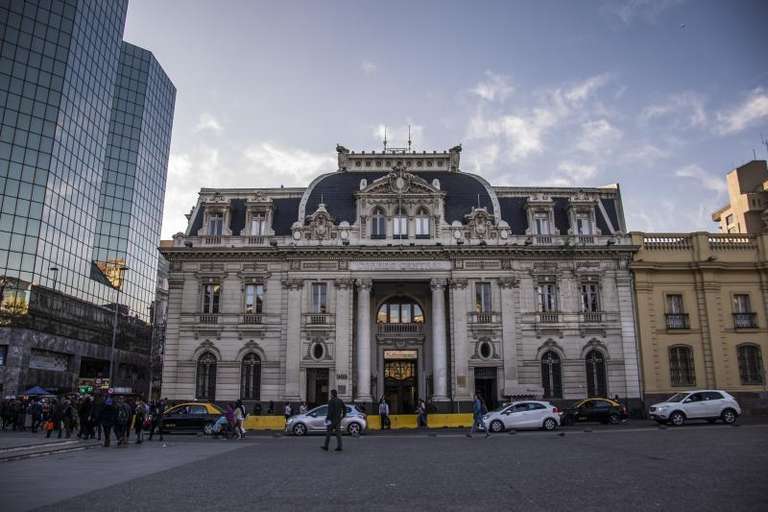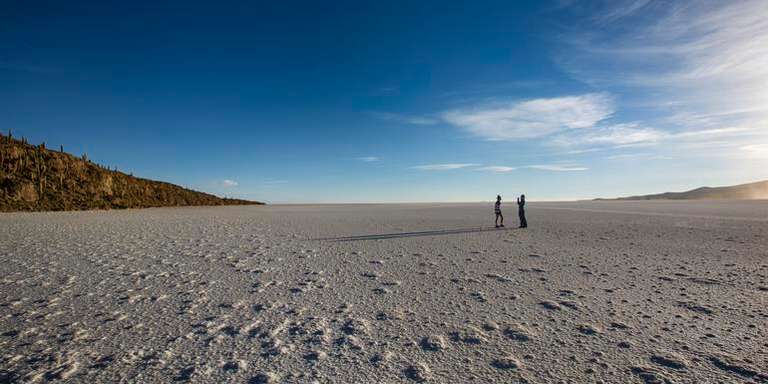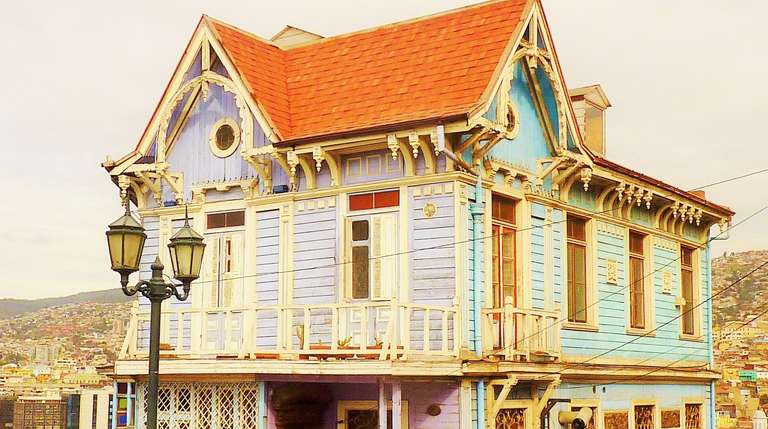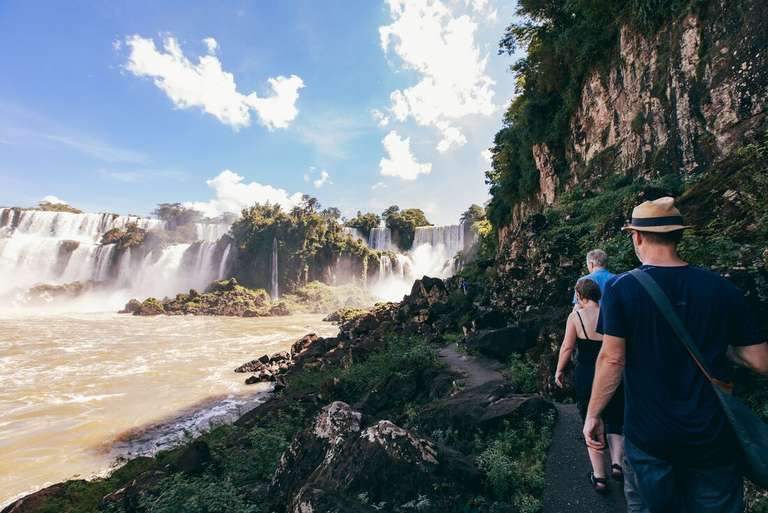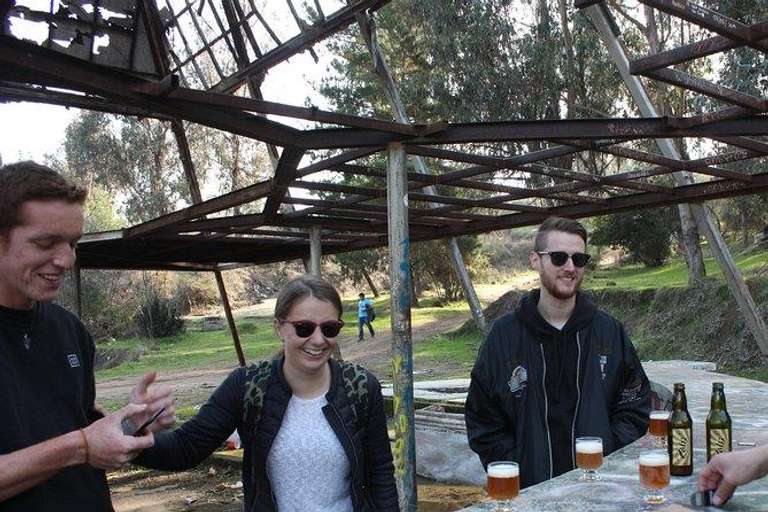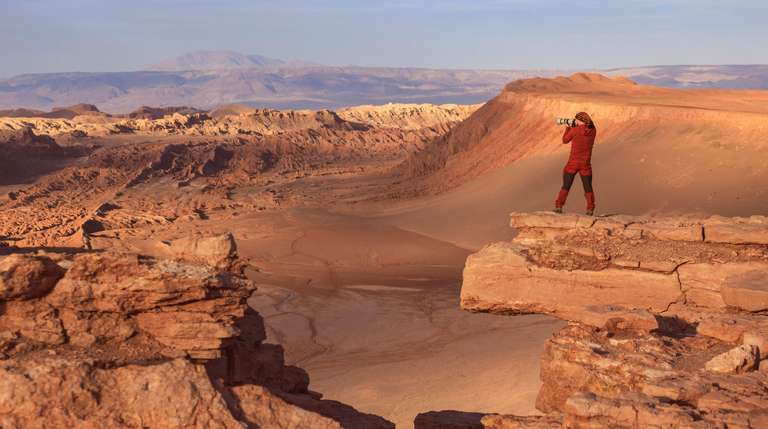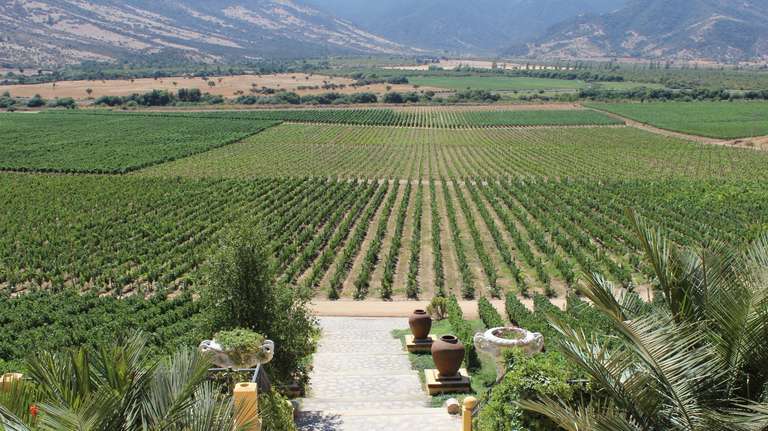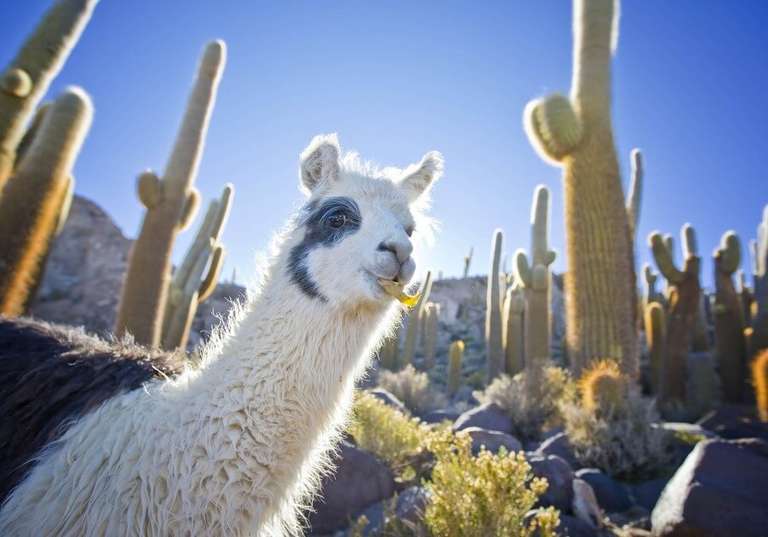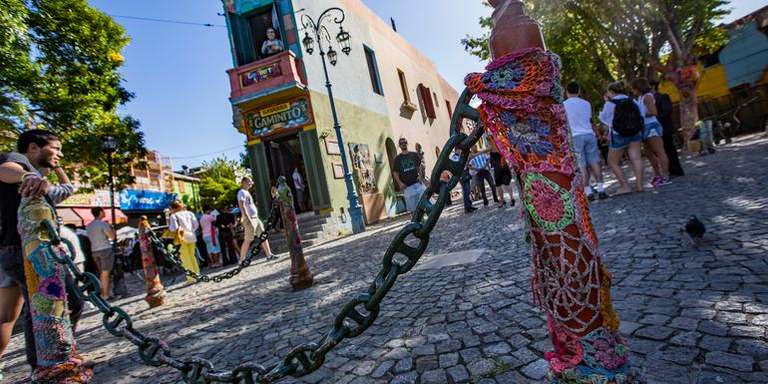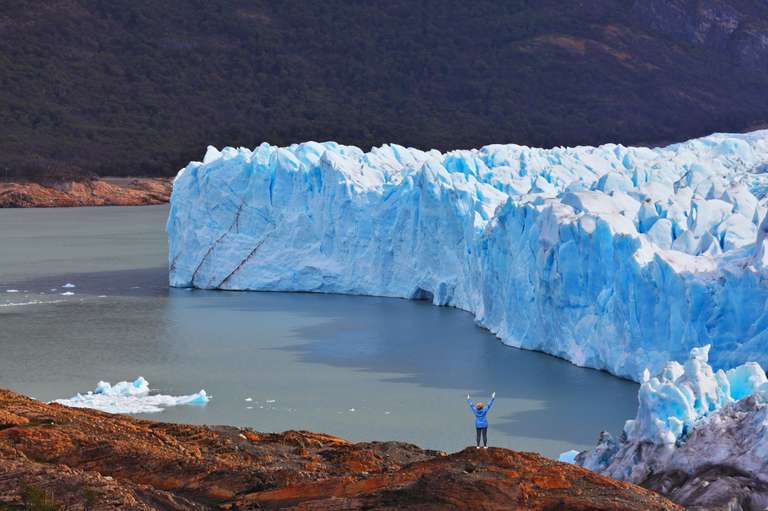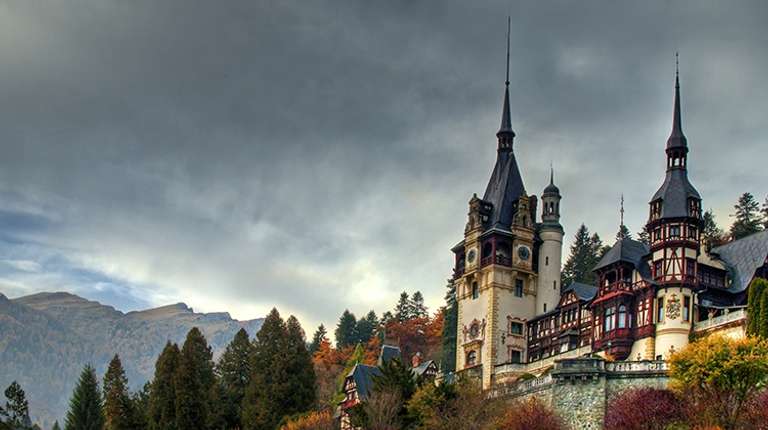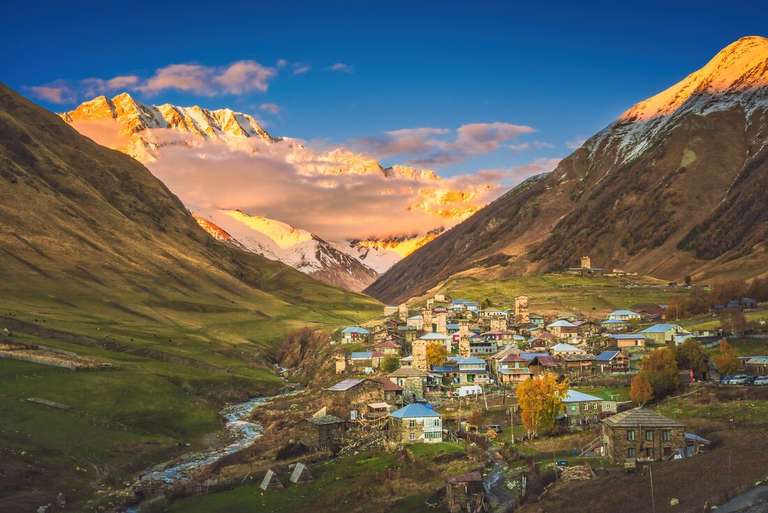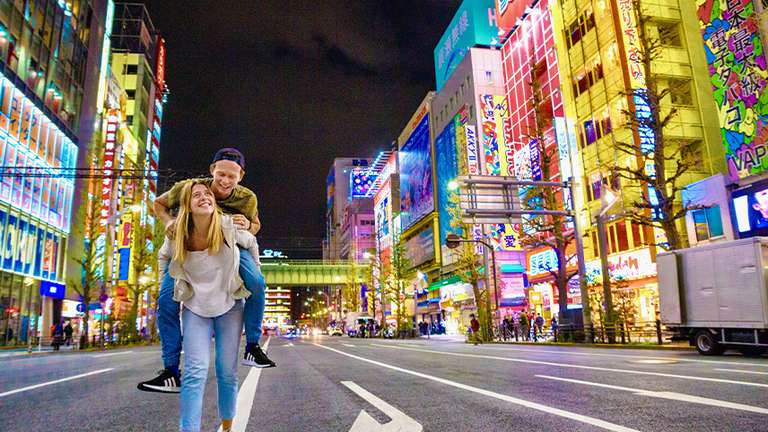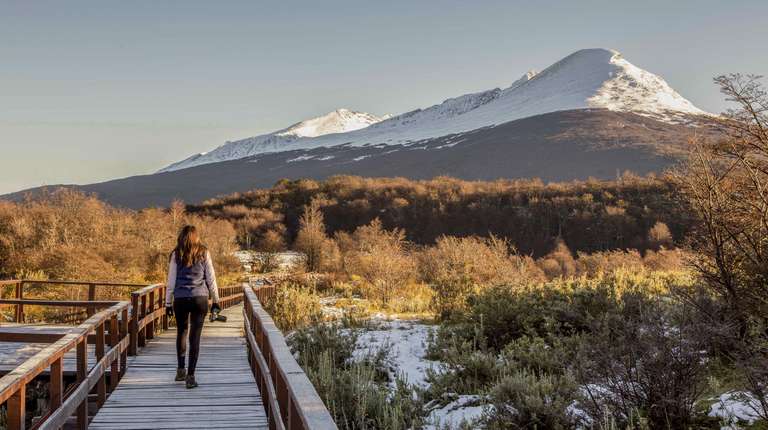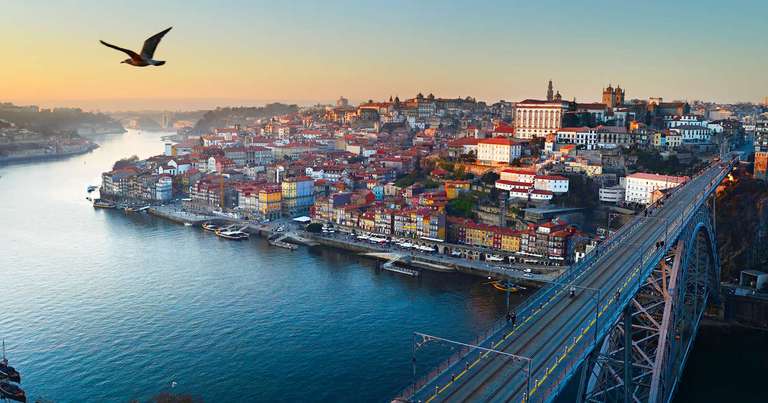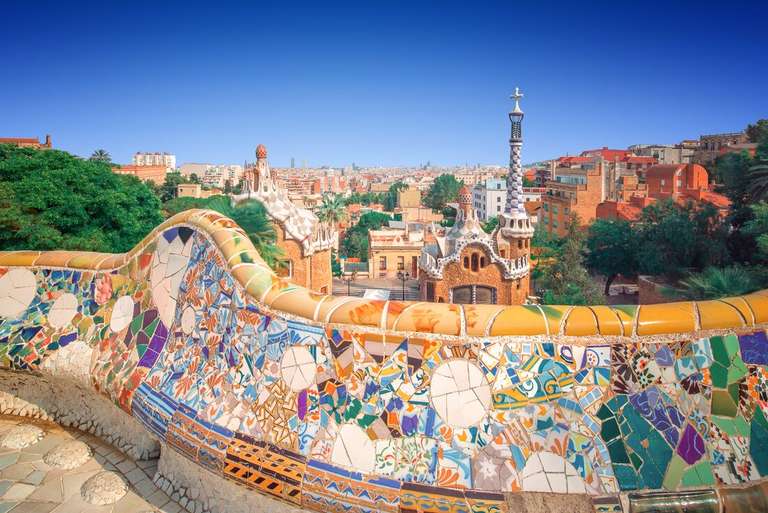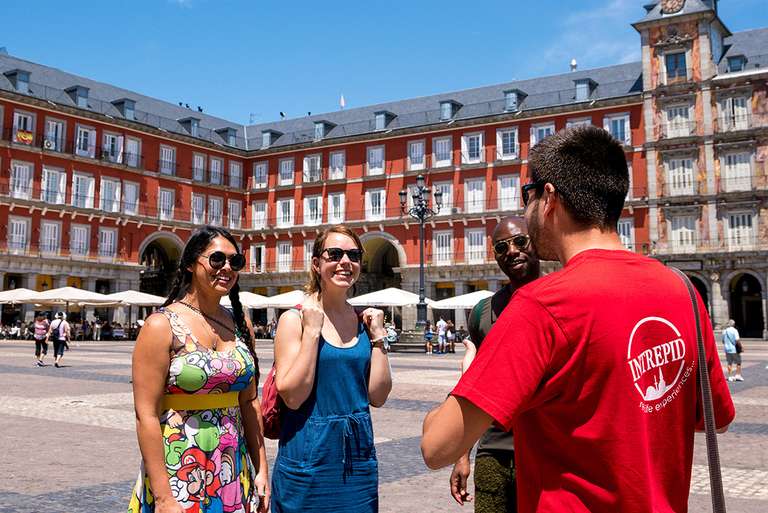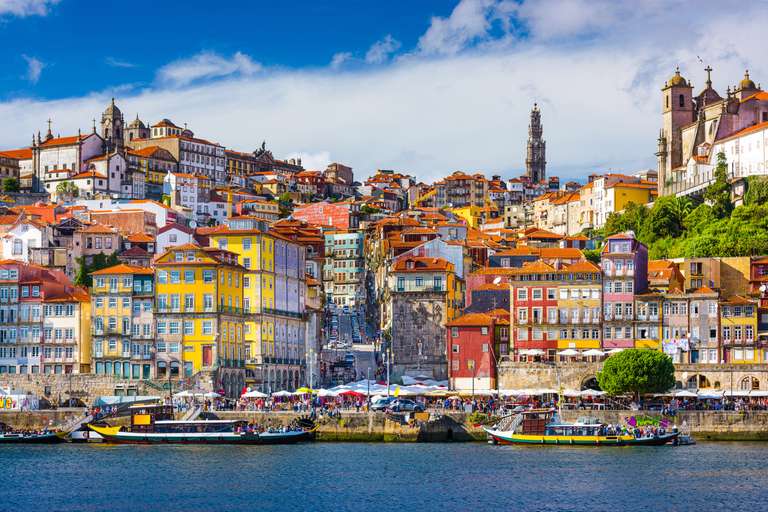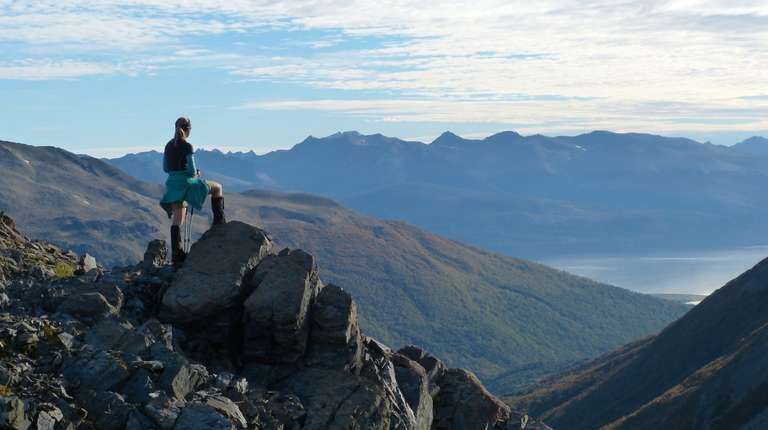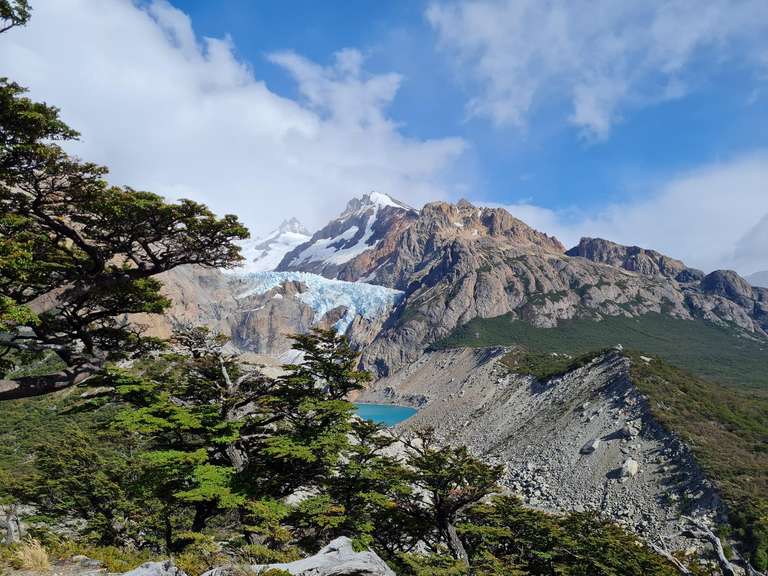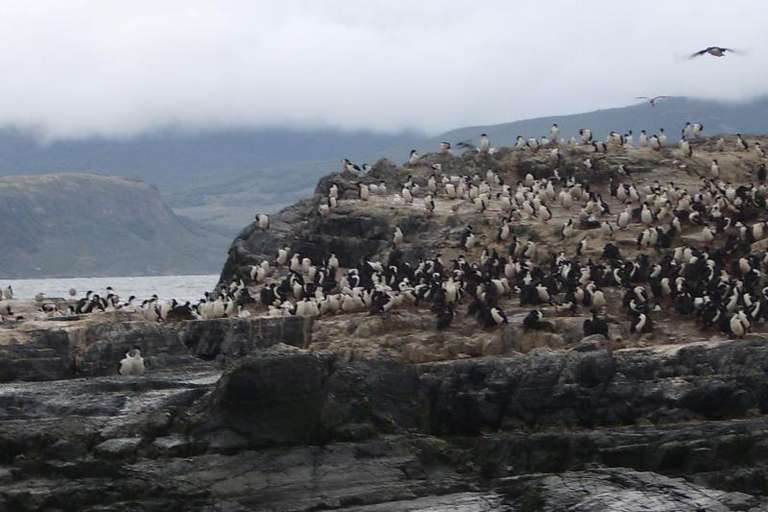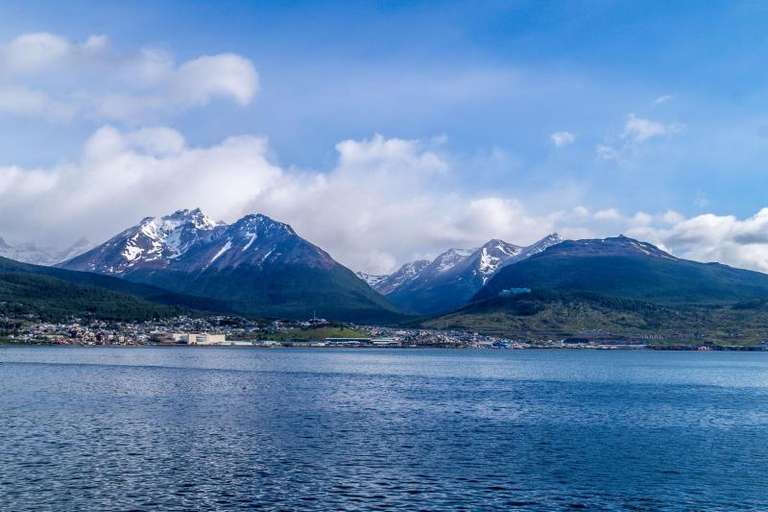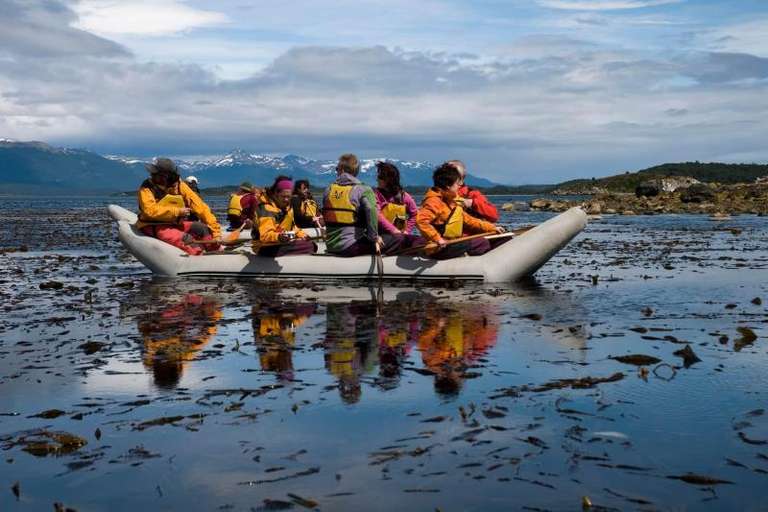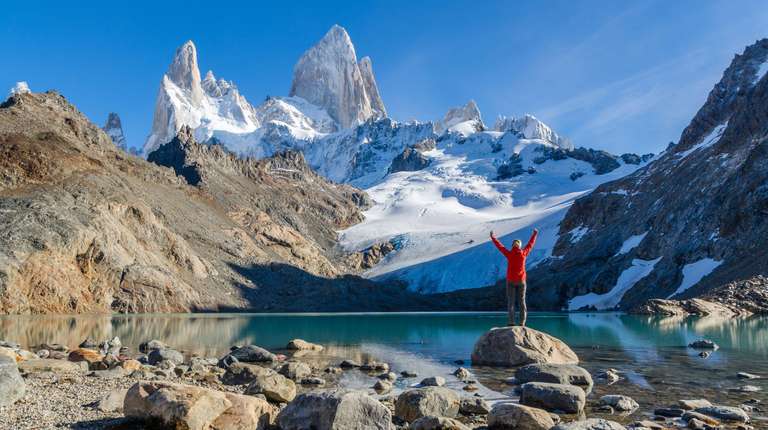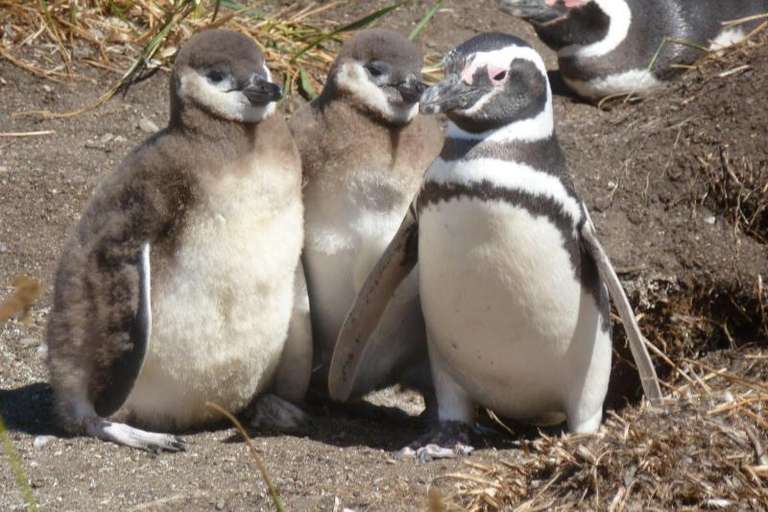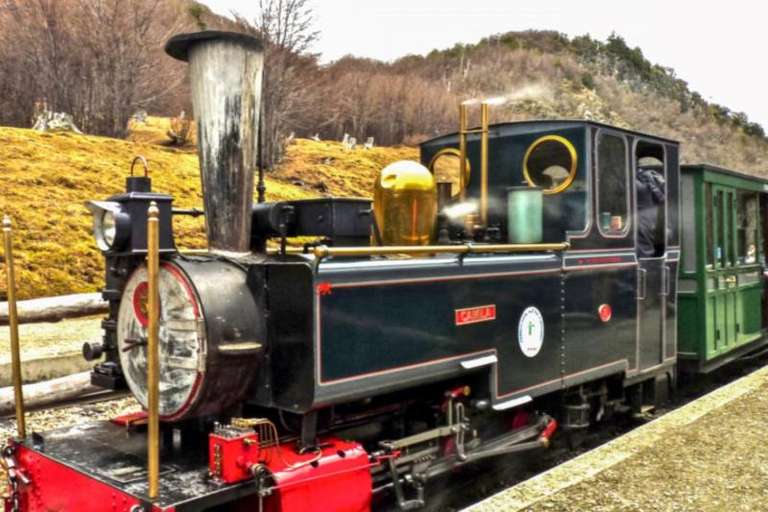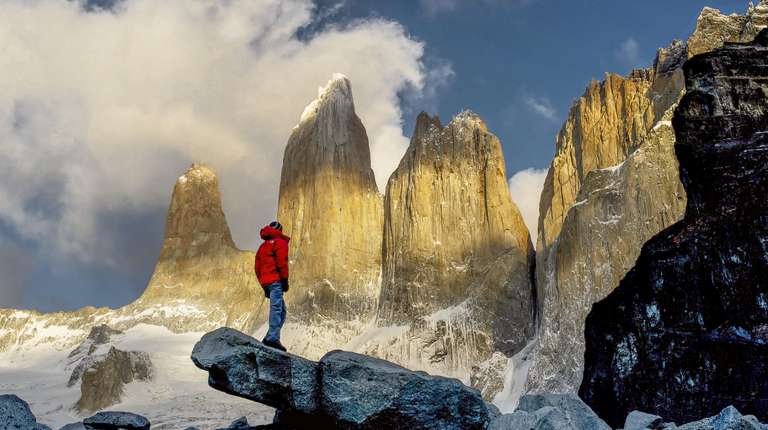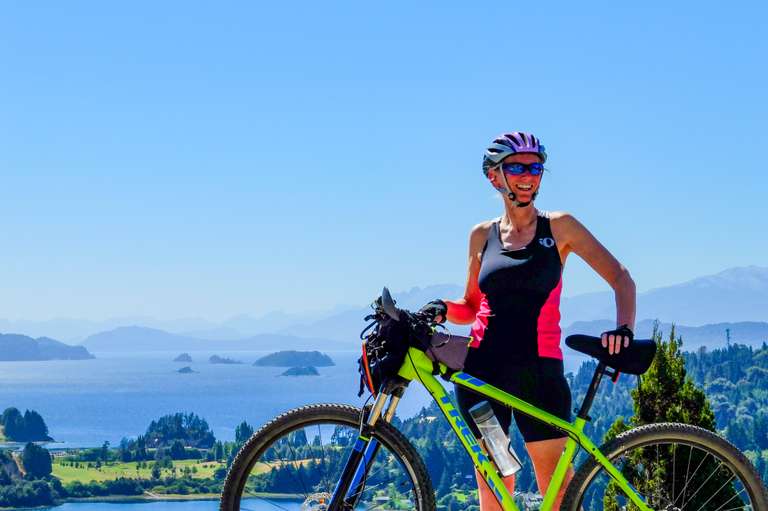12 Best Places to Visit in Chile

- Kimberly G
- From
- Kimberly G
- From
- Maria A
- From
- Stephanie Z.
- From

Famous for epic trekking, monstrous glaciers, tranquil lakes, and iconic rock formations, Torres del Paine National Park is arguably Chile’s most sought-after attraction. Adventurous travelers flock to Chile’s Patagonia region to spend their days ogling unbeatable natural beauty and nights spent camping under the stars.
- What to do: The W trekking tour is the best-known trekking trail and takes visitors past the park’s worthiest sights like Torres del Paine, Glacier Grey, Los Cuernos and Valle del Frances.
- When to visit: The best time to visit Torres Del Paine is between December and February. Although this is the high season and the park gets busier, it’s also dry and warm—perfect conditions for hiking and enjoying the park’s incredible viewpoints.
- Crowds: During the high season Torres Del Paine is at its most crowded, but this mainly applies to guesthouses and hotels which book up quickly. The park itself is also busy, but its sheer size means you’ll be certain to find many beautiful spots all to yourself.
- How to get there: The nearest airport to Torres Del Paine is Punta Arenas, but if you’re coming from Buenos Aires, there aren’t any direct flights. Instead, the best way to reach the park is by flying to El Calafate, from where you can take a bus trip of up to 5 hours to reach Puerto Natales. It takes around 2.5 hours to get into the heart of the park from Puerto Natales, but the views along the way are all part of the adventure!
Highlights:
- Marvel at the Majestic Cuernos del Paine, also called the iconic "Horns of Paine".
- Trek to Lake Pehoé, characterized by its crystal-clear, turquoise waters surrounded by jagged peaks. The trek offers breathtaking panoramas of the lake and its glacier-fed beauty, making it a photographer's paradise.
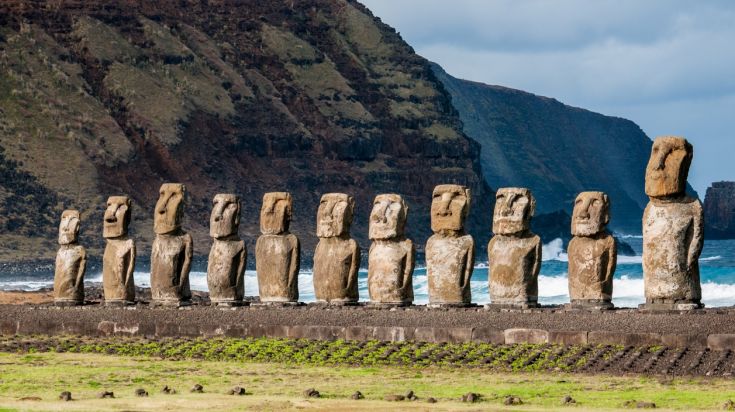
Lying over 3,219km off Chile’s eastern coast and 2,092km from any other populated piece of land, Easter Island is one of the most isolated inhabited places in the world and a photographer’s dream land. The volcanoes flow down to meet the beaches and the lush, rolling greenery makes an epic contrast to the untamed Pacific Ocean never lurking too far off in the background. Making the perfect model for photog’s portraits are the roughly 1,000 stone Moai statues.
- What to do: Don’t miss Rano Raraku and Ahu Tongariki boast the most impressive Moai statues. The former is thought to be the production site of the statues (housing over 400) and the latter has some of the largest, set on an incredible cliff-side location. Tip: Go at sunrise for photos of the sun splitting through the rocks.
- When to visit: Between April and November is the best time to head to Easter Island, when the weather is calm, mild, and not too humid. This is the best season to experience the most activities on Easter Island, although it can be a popular time to visit for others too!
- Crowds: Easter Island is popular year-round, from April to November due to good weather, in February for cultural celebrations, or in high season from January to March. Although you won’t be tripping over people at any time of year, Easter Island is very small so it may feel more crowded than you think.
- How to get there: Being one of the world’s most remote islands, Easter Island has no major cities nearby. The only way to reach the island is by plane, operated by LATAM, which flies there directly from Santiago in Chile. The journey takes around 6 hours.
Highlights:
- Witness the Moai statues at sunrise at Ahu Tongariki, where 15 massive Moai statues stand. Many visitors come to contemplate the mysteries of these unique, handmade structures.
- Explore Rano Raraku Quarry on a mesmerizing journey to the location where the Moai were carved. Hike along the rugged trails, surrounded by abandoned Moai in various stages of completion, offering a unique glimpse into the island's sculptural history.
3. San Pedro de Atacama
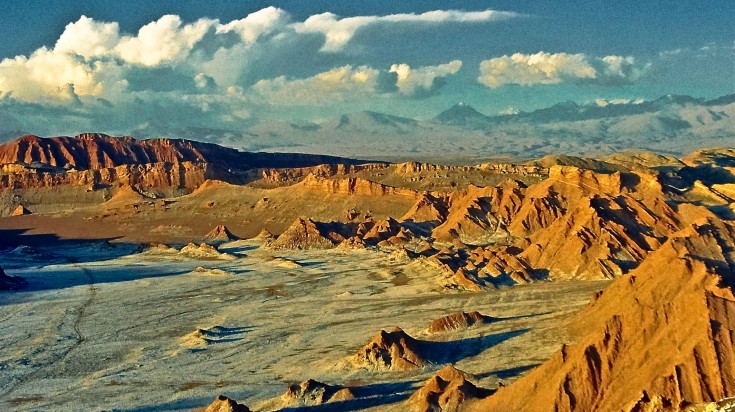
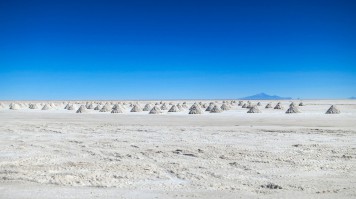
A small town built around an oasis on a desert plateau, roughly 5,000 people call San Pedro de Atacama home. The traditional way of life and other-worldly landscapes that expands throughout the Atacama Desert draw tourists who come to admire the naturally beautiful surroundings, simple lifestyles, and ancient culture that continues to thrive in the town. San Pedro de Atacama’s 16th century church is its iconic landmark and the Craft Village is the place to stroll through to witness the age-old local art traditions still practiced here.
- What to do: Moon Valley, with its lunar landscape, salt caves, and huge salt dunes molded by water and wind is undoubtedly a top place to visit in San Pedro de Atacama. Additionally, Tebinquiche Lagoon, part of the 1,200-square mile Salar de Atacama (Atacama Salt Flats) is a spectacular sunset vista area and photography hot spot.
- When to visit: There is no wrong time to visit the Atacama Desert, since it only rains six days per year. Sunshine is guaranteed! However, December to February offers warm, sunny summer weather. Avoid the desert between June and August when temperatures are freezing— sometimes it even snows.
- Crowds: San Pedro de Atacama can get crowded throughout the year, as it is such a small town and the gateway to the desert. Few people visit from June to August due to poor weather, and you’ll likely see the most crowds between December and February.
- How to get there: San Pedro de Atacama and its surrounding desert are remote but an extremely popular destination, meaning there is an easy route to get there. You’ll need to fly from Santiago to Calama Airport, from where you can jump on a shuttle bus to San Pedro, rent a car, or hire a taxi.
Highlights:
- Venture into the surreal lunar landscape of the Moon Valley (Valle de la Luna), where salt formations, sand dunes, and jagged rock formations create an otherworldly atmosphere.
- Embark on a colorful adventure in the Rainbow Valley (Valle del Arcoíris), named for its vibrant mineral deposits that paint the landscape with shades of red, green, and purple. Hike through this geological wonderland, exploring narrow canyons and taking in the stunning contrast of colors on the landscape.
4. Valparaiso
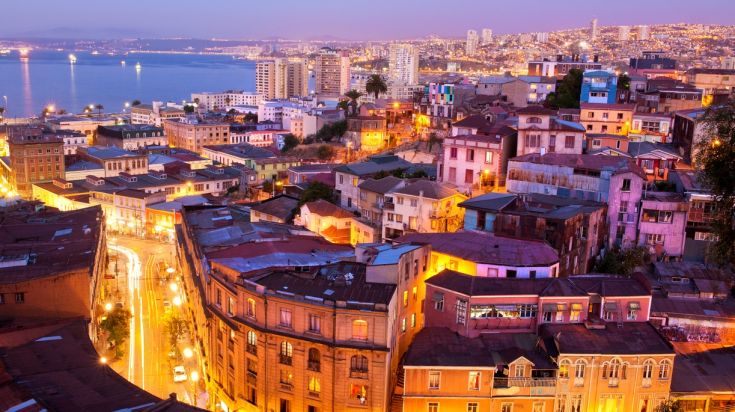
This bustling seaport lies 120km west of Santiago and possesses all the flairs and quirks one might expect from a World Heritage City. Valparaiso is praised for its rich culture and its ability to inspire local artists and poets. What should you do in town? Eat seafood, stroll the narrow streets, check out the city’s infamous collection of street art, peruse the art galleries, discover gastronomic treats and gaze upon the city’s magnificent architecture from its many towering viewpoints.
- What to do: Climb the stairs or take the El Peral funicular to Valparasio’s Cerro Alegreneighborhood, chalk-full of lively spirits, artists, street performers, bars, restaurants, churches, and gorgeous homes. For the best seafood in town, head to Caleta Portales, a fishing town within the city that offers up the freshest catches of the day.
- When to visit: The best time to visit is between October to April when the weather is warm and dry.
- Crowds: December to February sees the most crowds in Valparaiso, but many locals leave the city to escape to cooler areas on holiday while the tourists take over.
- Main city & how to get there: Valparaiso is a quick trip from Santiago by car—just 1.5 hours in fact. This is the easiest way to arrive, or alternatively, there are also local buses that go to Valparaiso from central Santiago.
Highlights:
- Wander through the maze-like streets and vibrant alleys of Cerro Concepción, one of Valparaiso's picturesque hills. Admire the street art and murals that adorn the buildings, and take in panoramic views of the harbor from Paseo Gervasoni.
- Immerse yourself in the world of Chilean poet Pablo Neruda by touring La Sebastiana, one of his former residences turned into a museum, and be enchanted by the panoramic views of the city and the sea from the top floor.
Find out the best options to get to Valparaiso from Santiago.
5. Santiago
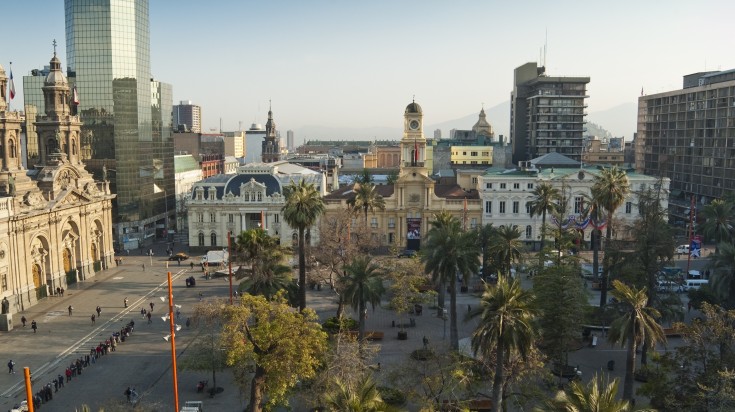
The country’s capital and the largest city is an obvious place to visit in Chile. This city offers a real taste and feel for what Chilean culture is all about. Explore its many neighborhoods, some of which provide a plethora of art galleries and others which are known for their markets selling local handicrafts. The historic city center has no shortage of museums and old buildings with impressive facades. Nightlife is also booming here — head to the Bellavista district to get your groove on.
- What to do: Explore Bellavista neighborhood. It is an artistic hub of boutique shops, art galleries, cafes, and houses some of the city’s best graffiti and street art. From here you can also trek to the top of the 914m St. Christopher Hill for city panoramas.
- When to visit: The summer season (July to August) is the best time to visit Santiago. Many locals leave during this time and the city is quieter, the weather is pleasant and the days are long.
- Crowds: Chile’s summertime, between December and February, is generally the busiest time in the city due to hot weather and a variety of celebrations.
- How to get there: Santiago has a major international airport with direct flights to the USA, Europe, Asia, and beyond.
Highlights:
- Take a cable car to the summit of San Cristóbal Hill for breathtaking panoramic views of Santiago's sprawling cityscape and the majestic Andes Mountains.
- Indulge in the flavors of Chilean cuisine at the bustling Central Market (Mercado Central), such as the renowned Chilean seafood stew known as caldillo de congrio.
6. Wine Valley

For the foodies and the wine lovers, a trip to the wine valleys south and west of Santiago top the list of places to visit in Chile. Chilean vineyards quickly climbed the ranks and now claim a spot amongst the best wine producing regions in the world. There are several valleys battling for the spotlight, but the three best-known around Santiago are Maipo Valley, Colchagua Valley, and Casablanca Valley. The latter is Chile’s only cool-climate wine producing region and is known especially for its excellent white wines and pinot noir.
- What to do: Check out Quintay Wine Estate and taste their perfected sauvignon blanc and Kingston Family Vineyards or Casa Botha for on-point pinot noir.
- When to visit: To sample wines and witness the harvest, visit between March and May, when most grapes are harvested and the region is particularly beautiful. However, wineries are open year-round so you can go anytime.
- Crowds: Chile’s wine regions, such as the Maipo Valley and Colchagua Valley, are busiest during harvest season, but visit towards the end and the crowds may ease off slightly.
- Main city & how to get there: Chile’s wine regions are huge and diverse, spread across most of the country. The best way to see one or a selection is via a tour—the most famous are the Maipo Valley and Casablanca Valley, which can be reached on a short drive from Santiago and Valparaiso respectively.
Highlights:
- Embark on a guided tour through the scenic vineyards of Maipo Valley, where you can stroll through rows of grapevines and learn about winemaking techniques against a backdrop of the Andes Mountains.
- Sip on classic Chilean wines such as carménère or cabernet sauvignon paired with local dishes such as empanadas or seafood paella.
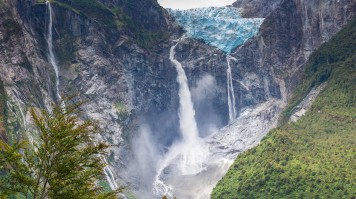
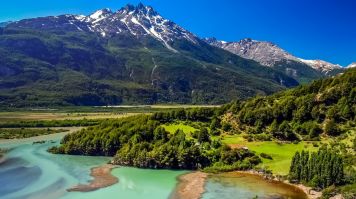
Road trippers, this one’s for you. Cruise through rural Patagonia following over 1,200km of road on Route 7 while enjoying pristine natural beauty and possibly the freshest air in the world. The starting point lies in Puerto Montt and the road terminates in Villa O’Higgins. The remote stretch of road winds through several National Parks, along wild rivers and lakes, through untouched forests, and past glaciers and mountain ranges. Traveling the whole route from start to finish includes 3 ferry crossings. It’s a big time commitment, but if you’re seeking some alone time amidst nature, make the trip.
- What to do: The Queulat National Park — known for its untouched evergreen forests, temperate rainforest and miles-long glaciers — is an obvious must-visit. Tackle the rugged trekking on Cerro Castillo — a mountain 100km south of Coyhaique — promising jagged peaks, hanging glaciers and a gorgeous turquoise glacier lake.
- When to visit: The best time to visit Carretera Austral The best time to visit Carretera Austral is between November and April, when the weather is at its best, although keep in mind the weather in Patagonia can be unpredictable!
- Crowds: November to December, and March to April, are the best months for visiting in terms of crowds. Although they’re still popular with visitors, they are far less crowded than in January and February when prices spike and locals have their school holidays.
- How to get there: You’ll need to rent a car or do a tour of Carretera Austral. If you’re coming from Santiago, there are flights to Puerto Montt, in the north of the region, and Balmaceda, in the south, both of which have car rental options, tours, and their own set of attractions.
Highlights:
- Embark on an unforgettable drive along this scenic highway that winds through some of Chile's most pristine and remote Patagonian landscapes, seeing dense rainforests, emerald lakes and rushing rivers along the way.
- Hike through Queulat National Park over suspension bridges and through ancient forests to visit the awe-inspiring Queulat Hanging Glacier.
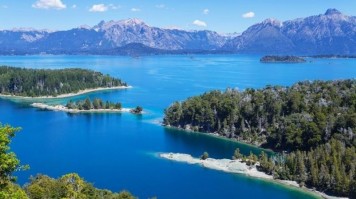

Chile’s most naturally scenic district runs 547km from Temuco in the north to meet Puerto Montt in the south. Renowned for gorgeous emerald lakes framed by snow-capped mountains and volcanoes, the Lake District provides endless vistas and incredible scenery. As beautiful and tranquil as the district is, it’s also known as an adventure capital. Rafting, zip lining, kayaking, volcano-climbing, hiking and alpine skiing are just some of the offerings. National Parks rule here, and no visit to the Lake District is complete without exploring one of them.
- What to do: Trek up Volcan Villarrica and ski or snowboard along the edge of crater while leaping from lava-flow formed halfpipes and eaves. The National Parks boasts spectacular day treks; the best way for appreciating all the Lake District’s glorious beauty. Shrouded in lush forest and temperate rainforest, Puyehue National Park’s trekking trails are some of the most impressive in the country. Bonus: the area’s German-inspired cuisine has made a name for itself and keeps travelers satisfied with hearty soups, meat, potatoes, and seafood.
- When to visit: Chile’s beautiful Lake District is the country’s wettest region, but for the driest weather, head here between October and April when the summer months bring slightly warmer temperatures.
- Crowds: As with many of Chile’s destinations, the Lake District gets busy with both tourists and locals in the summer months of January, February and even March. There will be fewer crowds if you visit in November and December.
- How to get there: From Santiago, you’ll need to fly or take a bus to Puerto Mott, the gateway to the Lake District. From here, there are dozens of cruises and tours which depart to explore the area.
Highlights:
- Head out on a hiking adventure in Conguillío National Park where you can admire the epic Llaima Volcano and walk amongst Araucarua (Monkey Puzzle) trees which date back thousands of years.
- Take a boat ride on the waters of Lake Todos los Santos, surrounded by snow-capped volcanoes, dense forests, and pristine wilderness—the ideal way to explore the remote wilderness of the Lake District.

Known better by its nickname as “The End of the World”, the aptly named, southernmost region in Chile is isolated albeit extremely intriguing. This triangular archipelago — explored by the likes of Charles Darwin and Ferdinand Magellan — presents a rough and rugged front that gives way to charming allure. This region can be explored on foot, but some of the most spectacular tours are conducted from the water.
- What to do: A boat trip to Cape Horn — the ominous black cliffs rising from thetreacherous seas — is an exhilarating excursion you’ll be talking about for the rest of your life. Another way to discover this region is by sailing or cruising through the magnificent fjords while stopping to trek along deserted coastlines and dramatic glaciers.
- When to visit: Months between October and April are the best to visit Tierra del Fuego, when the weather is warm. However, winter sports enthusiasts may prefer between June and September for excellent skiing.
- Crowds: The warmer months are the busiest time, both with locals and tourists coming overland or on cruise ships.
- How to get there: The quickest way to get to Tierra del Fuego is by flying to Ushuaia in Argentina. However, if you’re already in Chile, you can take the ferry from Punta Arenas to Puerto Porvenir, from where it’s around a 2-hour drive to get to Tierra del Fuego.
Highlights:
- Venture into the heart of Tierra del Fuego by exploring the region’s eponymous national park, where you can hike through Antarctic forests and spot native wildlife like foxes, guanacos, and seabirds.
- Meander along the water on a boat tour of the Beagle Channel, where you can observe glaciers, cliffs and colonies of adorable Magellanic penguins.
10. Chiloe

The island of Chiloe bursts with color and culture, instantly making visitors feel welcome and inspired. Chiloe’s striking landscape is complimented by brightly painted wooden churches (16 of which are UNESCO World Heritage Sites) and over-water stilted homes. Populating Chile’s fifth largest island are a spiritual people whose culture revolves around mythology, witchcraft and folklore, making Chiloe a strange yet irresistible destination in Chile.
- What to do: Horseback riding through the Chiloe National Park allows visitors to experience the rushing rivers, serene lakes, and long beaches framed by dark green forests. In contrast, visit the town of Castro where you can find a vibrant display of the island’s characteristic palafitos (colorful stilted homes), excellent seafood restaurants, and plenty of arts and crafts shops to satisfy all your souvenir-buying needs.
- When to visit: A great time to go to Chiloe is during the South American summer, which falls between December and March.
- What to pack: Due to its chilly weather, which can continue even into summer, cold weather clothes are essential. Make sure to bring a warm coat, hiking boots, cozy socks and a hat for particularly windy days by the water.
- How to get there: Chiloe may be an island, but it’s fairly easy to reach. There are direct flights from Santiago which take around 2 hours. Alternatively, you can take a bus from either Santiago or Puerto Montt, which takes 17 hours and 4 hours respectively, which is roughly the same if you’re self-driving. You’ll then need to catch a 25-minute ferry across the Chacao Channel.
Highlights:
- Explore Chilloe’s classic stilted houses known as palafitos in the charming town of Castro, by wandering the streets to see the area’s unique architecture.
- Immerse yourself in the Chiloe’s natural beauty on a hike through Chiloé National Park. Look for local wildlife like pudú deer and foxes, and enjoy the stunningly sheer cliffs and amazing coastline views.
11. Lauca National Park

Lauca National Park is the place to visit in Chile for high-altitude landscapes, breathtaking scenery and unusual wildlife. Encounter crystal-clear lakes, snow-capped volcanoes and expansive salt flats, which all offer unparalleled opportunities for hiking, photography and other outdoor activities. Marvel at the striking beauty of Chungará Lake, perched at over 4267.2 m above sea level, or venture along trails to encounter graceful vicuñas, Andean flamingos and other rare wildlife.
- When to visit: Lauca National Park can be visited at any time of year, whether in the warm, summer months, clear, dry months of March, May, September and October, or even in winter during July and August, when winter wildlife and fewer visitors transform the park into a peaceful wonderland.
- How to get there: Reaching Lauca can seem confusing, but it’s a popular area with frequent transport links. From Santiago, there are flights to Arica, from where there are buses to Putre, one of the gateways to the park. If you’re driving, the CH-11 Highway also links Arica with popular destinations, including Bolivia’s capital of La Paz, for a longer sightseeing trip.
Highlights:
- Lace up your hiking boots and explore the extensive network of trails that wind through areas of Lauca National Park, such as the stunning Payachatas Valley
- Discover the traditional Andean village of Putre, a gateway to the park, where you can find colonial architecture, bustling markets, and meet friendly locals who can tell you more about their way of life.
12. Robinson Crusoe Island

Robinson Crusoe Island is situated in the remote Juan Fernández Archipelago of Chile, and was named by the government to reflect its beauty, inspired by pirates, buried treasure and hidden caves. Explore a landscape overflowing with wildlife found nowhere else on earth, such the Juan Fernández firecrown hummingbird and the South American fur seal. The island is an outdoor lovers’ paradise, with kayaking, snorkeling, and hiking amongst hidden waterfalls, rugged coastline and submerged caves, with areas like Centinela Hill, Puntas de Isla, and Puerto Francés almost untouched by outsiders.
- When to visit: The best time to explore Robinson Crusoe Island is between October and April, when the weather is warm and dry, and you won’t get caught in the rain that falls in the rest of the year.
- What to pack: Lots of outdoor gear for exploring is essential for Robinson Crusoe, no matter what you plan to do. Hiking boots and a lightweight backpack for hitting the trails, swimsuits, snorkels and sunscreen for riding the waves, and above all, insect repellent for venturing into caves, waterfalls and jungles.
- How to get there: Robinson Crusoe Island is just a 2.5 hour flight from Santiago.
Highlights:
- Trek through the lush and untouched forests on Robinson Crusoe Island, which are home to endemic plant species like the Juan Fernández fern, and cascading waterfalls, such as El Yunque.
- Scuba divers can plunge into the crystal-clear waters surrounding the island to see rare marine life and underwater caves, or snorkel along vibrant coral reefs to spot colorful fish, sea turtles and the fur seal.
Chile is cultural playground set amongst pristine land seemingly untouched by humans. Age-old traditions strongly live on, preserving the country’s heritage. Magnificent mountains and remote trails beckon rugged travelers who are looking to get off the grid while the quaint towns found along the way appeal to those with a softer side. Whether your goal is isolated travel in nature or meaningful encounters with locals, the top places to visit in Chile offer all this and everything in between.
Likewise, for more information on activities to try in Chile, read our things to do in Chile article. Know where to go and what to do, but not sure how long it will require? Check out our guide on how many days to spend in Chile. If you have off-the-beaten-track destinations that aren't available in packaged holidays, how about planning a custom Chile trip that is personalized to your requirement?


